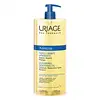What's inside
What's inside
 Key Ingredients
Key Ingredients

No key ingredients
 Benefits
Benefits

 Concerns
Concerns

 Ingredients Side-by-side
Ingredients Side-by-side

Water
Skin ConditioningGlycerin
HumectantHydrogenated Starch Hydrolysate
HumectantSodium Cocoamphoacetate
CleansingPEG-7 Glyceryl Cocoate
EmulsifyingSodium Cocoyl Glutamate
CleansingSodium Laureth Sulfate
CleansingSodium Laureth-8 Sulfate
CleansingCeteareth-60 Myristyl Glycol
EmulsifyingPolysorbate 20
EmulsifyingCoco-Glucoside
CleansingGlyceryl Oleate
EmollientSodium Chloride
MaskingCitric Acid
BufferingMagnesium Laureth Sulfate
CleansingSodium Oleth Sulfate
CleansingPolyquaternium-10
Magnesium Laureth-8 Sulfate
CleansingPEG-75 Shea Butter Glycerides
EmulsifyingMagnesium Oleth Sulfate
CleansingSodium Acetate
BufferingBrassica Campestris Sterols
EmollientRaspberry Seed Oil/Palm Oil Aminopropanediol Esters
Skin ConditioningWater, Glycerin, Hydrogenated Starch Hydrolysate, Sodium Cocoamphoacetate, PEG-7 Glyceryl Cocoate, Sodium Cocoyl Glutamate, Sodium Laureth Sulfate, Sodium Laureth-8 Sulfate, Ceteareth-60 Myristyl Glycol, Polysorbate 20, Coco-Glucoside, Glyceryl Oleate, Sodium Chloride, Citric Acid, Magnesium Laureth Sulfate, Sodium Oleth Sulfate, Polyquaternium-10, Magnesium Laureth-8 Sulfate, PEG-75 Shea Butter Glycerides, Magnesium Oleth Sulfate, Sodium Acetate, Brassica Campestris Sterols, Raspberry Seed Oil/Palm Oil Aminopropanediol Esters
Water
Skin ConditioningGlycerin
HumectantPEG-7 Glyceryl Cocoate
EmulsifyingSodium Cocoamphoacetate
CleansingLauryl Glucoside
CleansingCoco-Glucoside
CleansingGlyceryl Oleate
EmollientCitric Acid
BufferingPEG-90 Glyceryl Isostearate
CleansingMannitol
HumectantPolysorbate 20
EmulsifyingXylitol
HumectantLaureth-2
CleansingRhamnose
HumectantNiacinamide
SmoothingFructooligosaccharides
HumectantTocopherol
AntioxidantHydrogenated Palm Glycerides Citrate
EmollientLecithin
EmollientAscorbyl Palmitate
AntioxidantParfum
MaskingWater, Glycerin, PEG-7 Glyceryl Cocoate, Sodium Cocoamphoacetate, Lauryl Glucoside, Coco-Glucoside, Glyceryl Oleate, Citric Acid, PEG-90 Glyceryl Isostearate, Mannitol, Polysorbate 20, Xylitol, Laureth-2, Rhamnose, Niacinamide, Fructooligosaccharides, Tocopherol, Hydrogenated Palm Glycerides Citrate, Lecithin, Ascorbyl Palmitate, Parfum
 Reviews
Reviews

Ingredients Explained
These ingredients are found in both products.
Ingredients higher up in an ingredient list are typically present in a larger amount.
Citric Acid is an alpha hydroxy acid (AHA) naturally found in citrus fruits like oranges, lemons, and limes.
Like other AHAs, citric acid can exfoliate skin by breaking down the bonds that hold dead skin cells together. This helps reveal smoother and brighter skin underneath.
However, this exfoliating effect only happens at high concentrations (20%) which can be hard to find in cosmetic products.
Due to this, citric acid is usually included in small amounts as a pH adjuster. This helps keep products slightly more acidic and compatible with skin's natural pH.
In skincare formulas, citric acid can:
While it can provide some skin benefits, research shows lactic acid and glycolic acid are generally more effective and less irritating exfoliants.
Most citric acid used in skincare today is made by fermenting sugars (usually from molasses). This synthetic version is identical to the natural citrus form but easier to stabilize and use in formulations.
Read more about some other popular AHA's here:
Learn more about Citric AcidCoco-Glucoside is a surfactant, or a cleansing ingredient. It is made from glucose and coconut oil.
Surfactants help gather dirt, oil, and other pollutants from your skin to be rinsed away.
This ingredient is considered gentle and non-comedogenic. However, it may still be irritating for some.
Learn more about Coco-GlucosideGlycerin is already naturally found in your skin. It helps moisturize and protect your skin.
A study from 2016 found glycerin to be more effective as a humectant than AHAs and hyaluronic acid.
As a humectant, it helps the skin stay hydrated by pulling moisture to your skin. The low molecular weight of glycerin allows it to pull moisture into the deeper layers of your skin.
Hydrated skin improves your skin barrier; Your skin barrier helps protect against irritants and bacteria.
Glycerin has also been found to have antimicrobial and antiviral properties. Due to these properties, glycerin is often used in wound and burn treatments.
In cosmetics, glycerin is usually derived from plants such as soybean or palm. However, it can also be sourced from animals, such as tallow or animal fat.
This ingredient is organic, colorless, odorless, and non-toxic.
Glycerin is the name for this ingredient in American English. British English uses Glycerol/Glycerine.
Learn more about GlycerinGlyceryl Oleate is the ester of glycerin and oleic acid. This ingredient is mainly an emollient and emulsifier.
Emollients soften and hydrate the skin by creating a thin film on top to trap in moisture. As an emulsifier, glyceryl oleate helps stabilize formulations by preventing ingredients such as oil and water from separating. According to a manufacturer, this ingredient helps helps thicken water-in-oil formulations, shower gels, and hair shampoos.
In some products, this ingredient may be used as a fragrance / perfuming ingredient. The scent of this ingredient is described to be "waxy".
Glyceryl oleate is created from oils rich in oleic acid, such as peanut oil and olive oil.
This ingredient may not be malassezia folliculitis safe.
Learn more about Glyceryl OleatePeg-7 Glyceryl Cocoate is created from polyethylene glycol and fatty acids from coconut oil.
It is a synthetic polymer with emulsifying and cleansing properties.
As an emulsifier, Peg-7 Glyceryl Cocoate prevents ingredients such as oils and water from separating. It also helps rinse away oils, dirt, and pollutants from skin.
Peg-7 Glyceryl Cocoate may not be fungal acne safe. It can also dry out skin.
Learn more about PEG-7 Glyceryl CocoatePolysorbate 20 is made by combining ethoxylation of sorbitan, ethylene oxide, and lauric acid. It is a mild cleansing agent, surfactant, and emulsifier.
As a surfactant, it helps collect dirt and oils for washing. Emulsifiers prevent oils and water from separating.
Polysorbate 20 also adds scent to a product. Since it is made using sorbitol, it has a sweet scent. Sorbitol can also be found in fruits such as apples and peaches.
The lauric acid used to create Polysorbate 20 is often derived from coconuts.
Polysorbate 20 may not be fungal acne safe.
Learn more about Polysorbate 20We don't have a description for Sodium Cocoamphoacetate yet.
Water. It's the most common cosmetic ingredient of all. You'll usually see it at the top of ingredient lists, meaning that it makes up the largest part of the product.
So why is it so popular? Water most often acts as a solvent - this means that it helps dissolve other ingredients into the formulation.
You'll also recognize water as that liquid we all need to stay alive. If you see this, drink a glass of water. Stay hydrated!
Learn more about Water